This World Cup coverage is made possible through the generous support of Marty and Kathy Hall and the A Hall Mark of Excellence Award. To learn more about A Hall Mark of Excellence Award or to learn how you can support FasterSkier’s coverage please contact info@fasterskier.com.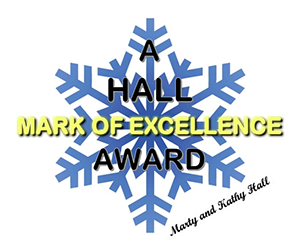
To set the scene for the Tour de Ski, briefly turn to an episode from the event that inspired it. Cue “the Badger,” Bernard Hinault, who at the start of the 1985 Tour de France reduced the three week race down to one question: “Look at the results last year – Laurent Fignon first, me second and Greg Lemond third. Now Fignon won’t be there. What answer do you get?”
The answer: Lemond and Hinault would battle as teammates in the greatest editions of the Tour de France ever in ‘85 and ‘86. In the end, Lemond “slayed the Badger,” besting Hinault to win the Tour in ‘86 and establish the Americans as winners at the Tour.
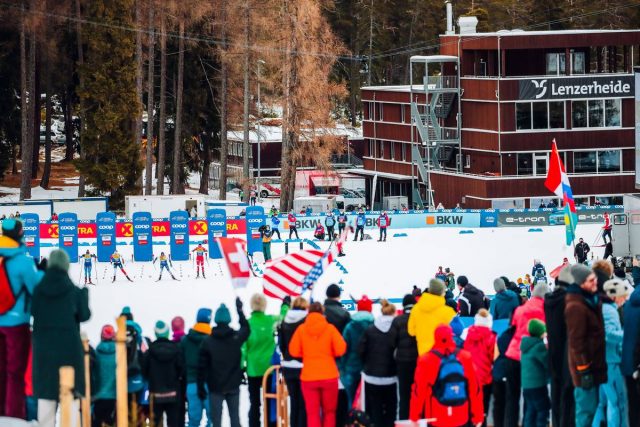
Switch seasons, sports, and circumstance and we can reduce this year’s Men’s Tour de Ski (TDS) to one question too: Look at the results last year – Alexander Bolshunov (RUS) first, Maurice Manificat (FRA) second, Denis Spitsov (RUS) third. Johannes Høesflot Klæbo (NOR) was not there. Now he is back. What answer do you get?
The answer: Klæbo.
In the first stage of this year’s Tour de Ski at Lenzerheide, the Overall and Sprint leader of the World Cup came into the freestyle sprint, and looked in control each time he headed out on the 1.5-kilometer course, winning the qualifier (2:36.66) before cruising through the quarterfinals and semi-finals to keep his yellow World Cup Sprint leader’s bib as he exited the final.
But back-up, and you see another parallel to Lemond at cycling’s Tour, with today’s stage marking the ascendancy of the Americans. They put three in the top 30, with Ben Ogden finishing qualifying in 5th place (+5.81sec), Kevin Bolger in 9th place (+6.62), and Logan Hanneman in 30th (+9.78).
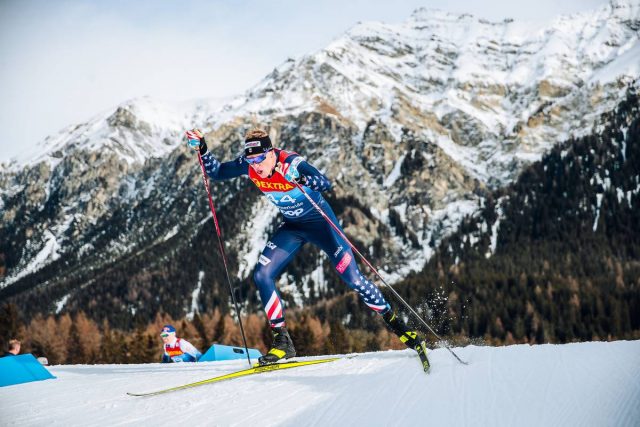
In the quarterfinals the first three heats were marked by somewhat conservative tactical posturing, with a field figuring out how to race the course at Lenzerheide after a two year absence. There was a good reason too. The two 750m laps are marked by a steep initial climb that after a turn gives way to a long downhill whose end is a sharp left into the stadium. That sharp left proved time and again to eliminate the gaps that attacking skiers tried to create on the first climb. It also led to opportunities to find a good position for the final sprint and pick up places in the field.
That was how Klæbo looked to race the first quarterfinal of the day, following Lucas Chanavat (FRA) into the second downhill before launching to the outside to capture the heat in the final stretch. Logan Hanneman seemed to mirror Klæbo’s moves through the heat, tucking in behind him on the downhill the 2nd time but finding that he hadn’t pushed with the same energy, as he said in comments to Fasterskier: “Klaebo and Chanavat pushed harder than I did over the top of the climb on the second lap and all of the sudden then had some meters on me. It’s easy to think that others had faster skis than myself today since I got passed on the long downhill the second lap, but that probably only because I didn’t see what they were doing behind me. I am sure they skated harder than I did and built up more energy to come by me.” Hanneman finished the heat in 5th place.
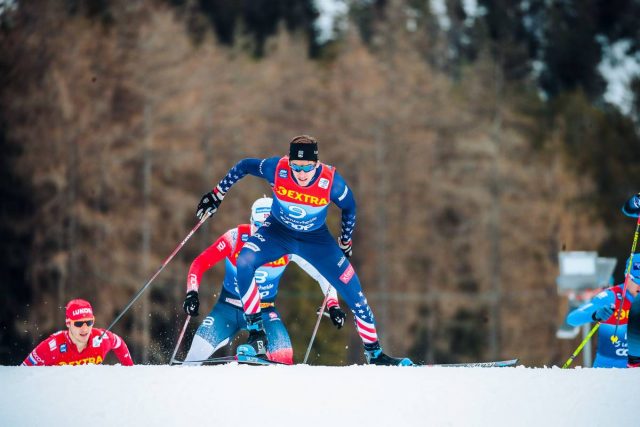
Bolger and Ogden opted to race out of the 4th and 5th quarterfinal, respectively, being the top qualifier in each. In contrast to Hanneman’s approach, the two both went with the strategy of leading out the field and trying for the gap on the first downhill. Both Ogden and Bolger’s attacks had the effect of animating their heats, which led to full bore racing for the entirety of the 1.5k course and eventually faster times across the field.
Their aggressive racing was foiled by the sharp left turn into the finishing straight, with the fields coming together and both Ogden and Bolger losing their position at the front of the field.
Bolger came across the line of his heat in 4th place, but his move early on to set a fast pace for the heat paid off, temporarily earning him a lucky loser spot. After the 5th heat though, where Ogden finished in 5th, Bolger was knocked out of the final lucky loser spot by Alexander Terentev (RUS) by less than 0.8 seconds.
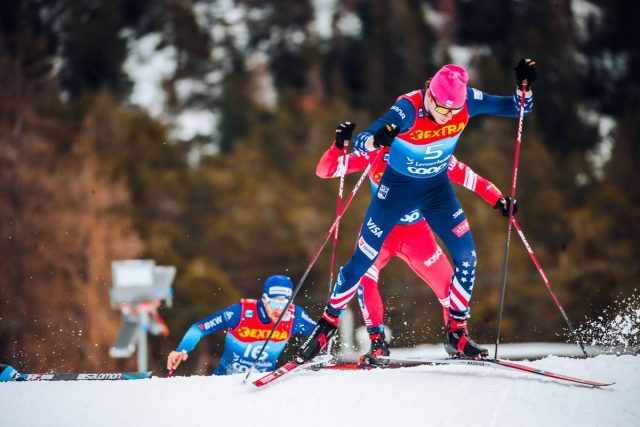
Still, the Americans’ quarterfinal performances left them in a strong position to challenge for the points classification, which will now turn to intermediate sprint primes at various checkpoints within the next two stages’ distance races.
It also left a semi-final field filled with familiar races from Tour de Ski’s past. Richard Jouve (FRA), Lucas Chanavat (FRA), and last year’s champion in the TDS Sprint Freestyle stage Fredrico Pellegrino (ITA). The younger sprinters who have featured on sprint podiums this season, Alexander Terentev (RUS) and Erik Valnes (NOR), were there too. Notably, last year’s Tour de Ski overall and points champion Alexander Bolshunov (RUS) was not, after being finishing 3rd place in his quarterfinal.
And, of course, there was Klæbo.
In the first-semi final, as the Frenchmen Jouve and Chanavat moved to the front of the pack at the beginning of the heat, Klæbo tucked in right behind them. As they came out of the first lap, Klæbo followed Pellegrino’s attack on the climb, but didn’t really look to make his move until the last downhill. Here he demonstrated an approach to the climb that was absent elsewhere in the men’s field the rest of the day, sprinting in a tuck skate to hit the apex of the final turn in a way that shut the door on the rest of the field.
Did he have the purest burst of speed on the finishing stretch? Probably. But it was already over before he hit that stretch, and he crossed comfortably in first place.
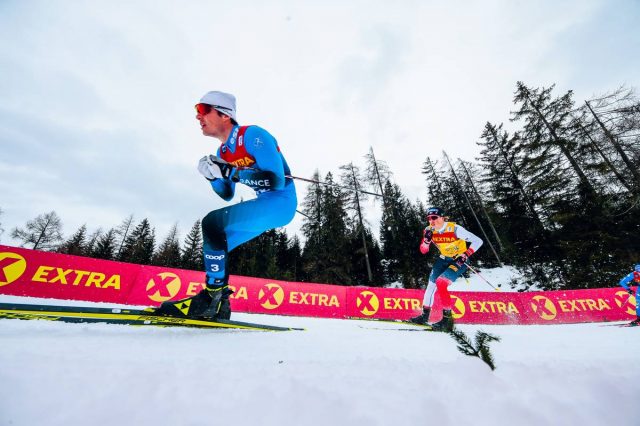
Chanavat and Jouve’s attacks early in the race had a similar effect on the semi-final as the Americans did in the quarterfinal. The first semi-final proved to be the faster field, and so Jouve (2nd), Chanavat (3rd), and Pellegrino (4th) all progressed to the final.
There they were joined by two more Norwegians, Pål Golberg and Erik Valnes, who followed their countrymen’s lead in the second semi-final heat to out-sprint Renaud Jay (FRA).
The final followed the pattern established in the previous round. Chanavat and Jouve seemed mindful that their chance to beat Klæbo most likely lied in a long-burn attack that saw him, Valnes and Golberg left out of the pack going into the second lap. Unfortunately, again, that attack met the long downhill sharp left turn.
Klæbo seemed content to simply keep up with Pellegrino as he made a move on the final climb of the day, before sweeping to the outside and attacking the final downhill to leave the rest behind before that pesky left turn could shake-up the field again. He crossed in first place, with Jouve in 2nd (+.99) and Chanavat in 3rd (+1.26).
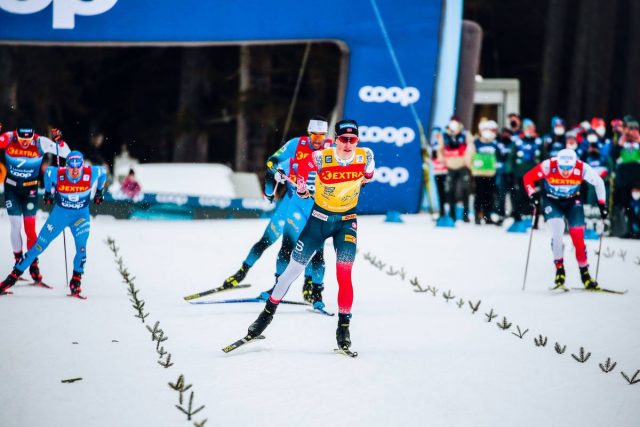
With the win, he established himself on an early, but clear path, to retake the Tour’s Overall and Point classifications after missing last year. His win today also helped him move up the ranks in the Tour’s history, passing Dario Cologna and Martin Johnsrud Sundby’s 7 stage wins to move him into 3rd all-time with 8 – behind Sergey Ustiugov (9), and Petter Northug (13). He also extended his all-time individual sprint stage lead in TDS history to 5.
So while we came into today’s stage with one question, we head towards tomorrow’s 15km with many. Just how much more history can Klæbo make? Will Bolshunov re-establish himself as a contender? And where do the American men go from here in this year’s Tour de Ski?
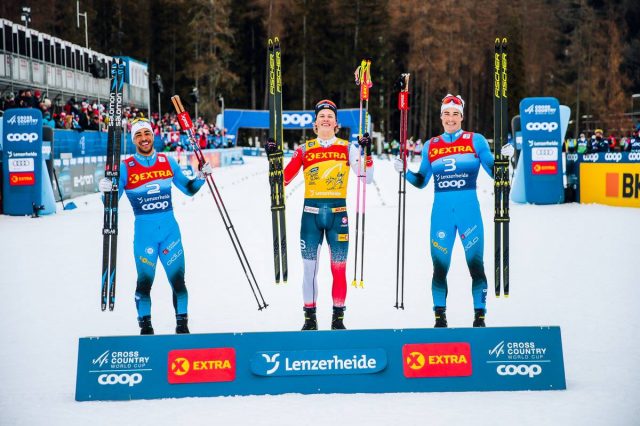
For now, the Yellow bib (“le bavoir juane” anyone?) remains on Klæbo’s shoulders, and our eyes on Lenzerheide tomorrow.
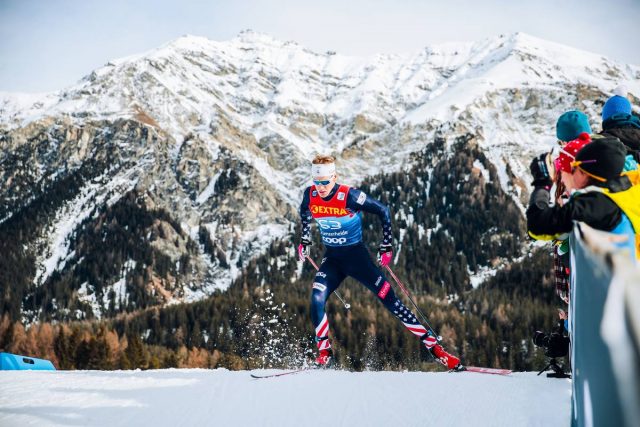
After the semi and final rounds were decided, Bolger ended his day in 16th (+1.75), with Ogden in 21st (+1.94), and Hanneman in 25th (+5.70).
The rest of the American men also showed strong results in the qualifier today. Luke Jager finished in 45th (+12.57), with Gus Schumacher in 55th (+13.95). Minnesota’s very own Zak Ketterson also made his World Cup debut, finishing in 72nd (+16.37) after qualifying for the Tour de Ski as the men’s SuperTour leader after racing Period 1 back in the States.
On his race into the quarterfinals today, Logan Hanneman said “I’m feeling pretty good after today, but still longing for more. It has been a very slow and disappointing start to the season for me, for reasons I can’t explain. I am happy to be seeing progress in the right direction the last two sprints that I have done, but there is still a lot of work left to be done to reach my goals. I am looking forward to trying my hand at some distance races starting tomorrow!”
Post-race interview with Matt Whitcomb on the course in Lenzerheide, which has suited Americans well over the years, along with additional comments on the men’s and women’s races.
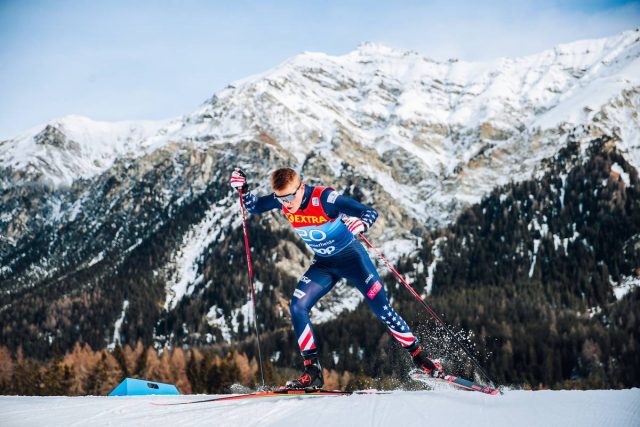
Results from Stage 1:
Ben Theyerl
Ben Theyerl was born into a family now three-generations into nordic ski racing in the US. He grew up skiing for Chippewa Valley Nordic in his native Eau Claire, Wisconsin, before spending four years racing for Colby College in Maine. He currently mixes writing and skiing while based out of Crested Butte, CO, where he coaches the best group of high schoolers one could hope to find.



